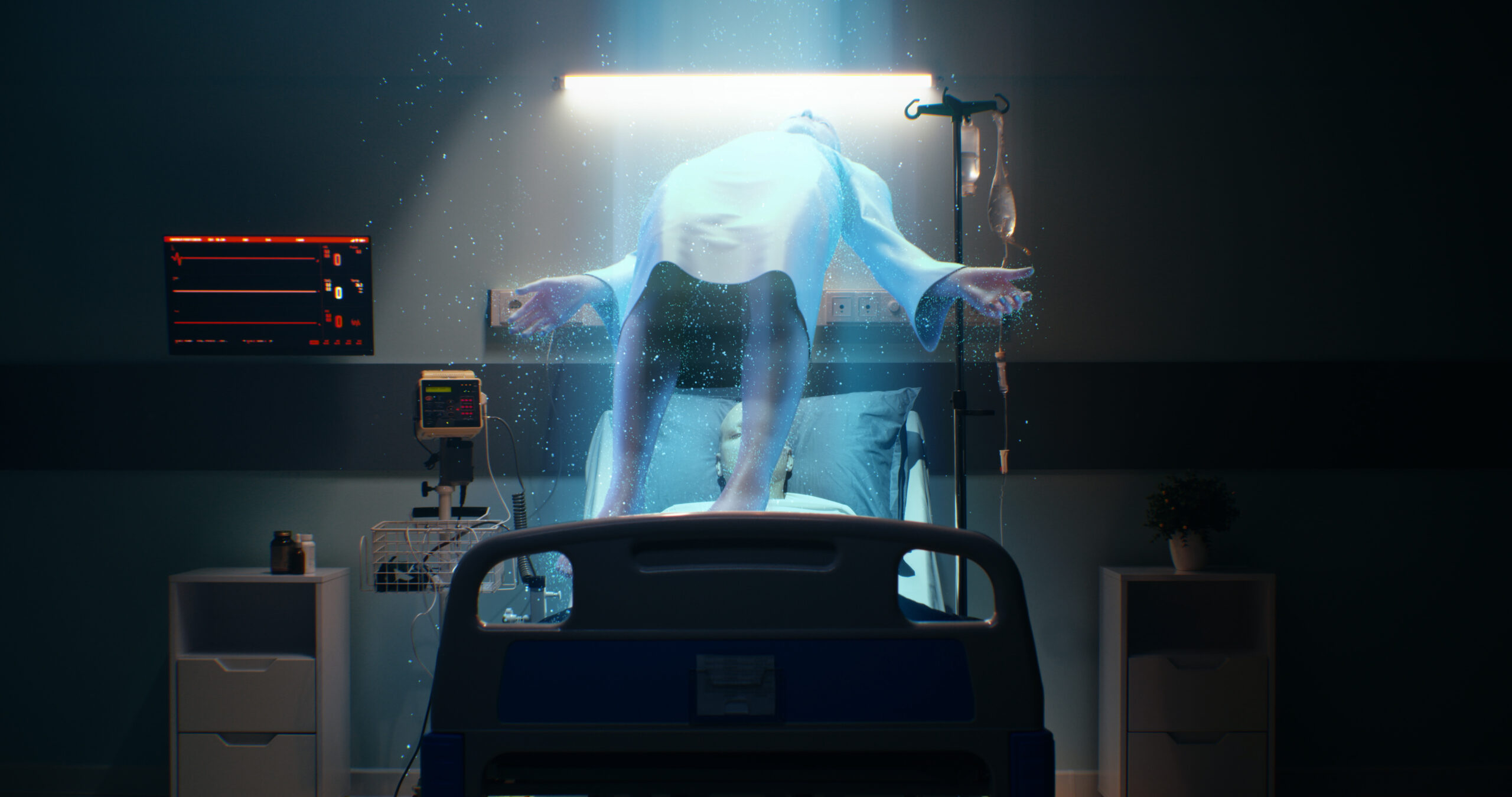Scientists Claim to Have Discovered Evidence of ‘Soul’ Leaving the Body When We Die

Death is the one thing we all share, the one experience that unites us in our humanity. It’s inevitable, mysterious, and often feared, yet no matter how much we try to understand it, we can’t escape its hold. What happens when we take that final step? When the heart stops, the breath ceases, and life slips away? For centuries, people have turned to religion, philosophy, and personal experience to explain what occurs at the end of life. But now, science may be unveiling a groundbreaking discovery that could change everything we thought we knew about the dying process.
Could it be that the “soul,” as many spiritual traditions call it, doesn’t simply vanish when our bodies fail? Could there be scientific evidence that consciousness persists, even after the body has ceased to function? Recent research is offering something remarkable—evidence that the very essence of who we are might linger in ways we never imagined. Scientists have found that brain activity doesn’t just stop when we die—it surges, sparking a flurry of electrical signals that may offer a glimpse into the most profound mystery of all.
The Scientific Discovery of Brain Activity After Death
For decades, we believed that once the heart stopped beating, the brain shut down almost immediately. The prevailing notion was that death was a definitive event—one that brought everything to a halt. But new research is challenging this idea, suggesting that death is not a singular moment but a complex process. This revelation comes from an unlikely source: the very thing we thought was the endpoint—the dying brain.
Dr. Stuart Hameroff, an anaesthesiologist and professor at the University of Arizona, is one of the leading figures behind this breakthrough. Along with his team, Hameroff studied the final moments of critically ill patients. They attached small sensors to the brains of seven patients who were only minutes away from death. As their heart rates and blood pressures dropped to zero, the team observed something remarkable—a strange burst of electrical activity in the brain.
Hameroff explains, “We saw everything go away—the heart stops, the blood pressure disappears—and then, you got this activity. It’s almost as if something is still happening when there should be nothing.”
This phenomenon was unexpected and profound. No longer could we simply accept that brain activity ceases instantly when life slips away. Instead, bursts of energy, like ripples in a pond, spread through the brain even after all the signs of life had vanished. And this raises an intriguing possibility: could this surge of activity be a sign of consciousness—perhaps the very “soul”—leaving the body?
These findings challenge the long-held belief that consciousness is tied exclusively to a functioning brain. The idea that there is still something happening in the brain after the heart stops sends a powerful message: death is not as final as we once thought. Perhaps, just maybe, there is more to the dying process than we can currently understand.

What Does This Activity Mean?
Now that scientists have uncovered this unexpected surge of activity in the brain after death, the question arises: What does it all mean? Is this just a final electrical gasp from the brain, or could it signify something deeper—something beyond the physical? There are two main theories that emerge from these findings, each suggesting a radically different interpretation of what’s happening during these final moments.
The Near-Death Experience (NDE) Theory
One theory connects these bursts of brain activity to near-death experiences (NDEs). These experiences, which many people report during moments of clinical death or near-death, often include vivid visions of leaving the body, traveling through tunnels of light, or encountering deceased loved ones. Some describe feeling an overwhelming sense of peace and love, a profound understanding of life’s meaning, or even an encounter with a divine being.
Could these electrical surges be the brain’s way of facilitating these deeply transformative experiences? Dr. Hameroff and other researchers speculate that the surge in brain activity could be linked to the vivid, out-of-body sensations that many NDE survivors report. Perhaps, when the body shuts down, the brain is still in a heightened state of awareness—opening a door to experiences that transcend the physical realm.
The Soul Theory: Consciousness Leaving the Body

The second theory takes a more spiritual approach, proposing that these bursts of activity represent something more than just the brain’s last attempt to function. Could this be the soul leaving the body?
For centuries, various spiritual traditions have described the soul as something separate from the body—an essence that transcends the physical and endures beyond death. According to Dr. Hameroff’s research, the consciousness—the very essence of who we are—may persist after the body’s failure. He argues that this surge of activity could be evidence of the “soul” or consciousness moving beyond the physical form, dissipating into the universe after the body dies.
In Hameroff’s theory, this consciousness isn’t bound to the brain; rather, it exists in a quantum state that can’t be destroyed, only transformed. The bursts of energy we see after death could be the manifestation of this transition, as the mind or soul—however you choose to call it—moves on to whatever comes next.
What Does This Mean for Our Understanding of Death?
Both theories—one grounded in the brain’s physiological processes and the other in the spiritual notion of the soul—offer intriguing possibilities. These findings suggest that our understanding of death is far from complete. Perhaps, as science delves deeper into the complexities of brain function and consciousness, we’ll uncover more pieces of the puzzle, helping us answer one of the oldest questions humanity has ever asked: What happens when we die?
As we consider these findings, we are faced with an important question: What if consciousness isn’t tied to the body? What if, instead of simply fading into darkness, there is something more profound taking place in those final moments? Could we be on the verge of discovering that consciousness transcends the brain and body, suggesting that our essence—the soul—might continue after death?
Theoretical Connection to Quantum Mechanics
Dr. Stuart Hameroff’s theory of consciousness goes beyond traditional neuroscience, exploring the role of quantum mechanics in the brain. At the heart of his hypothesis are microtubules—tiny structures within cells that help maintain the brain’s function. Hameroff suggests that these microtubules might be capable of processing quantum information, essentially serving as the brain’s “quantum computer.”
According to Hameroff, when a person dies and the heart stops, the microtubules lose their quantum state. However, the quantum information contained within them does not simply vanish. Instead, it could dissipate into the universe, continuing in a non-local form. This suggests that consciousness may not be entirely tied to the physical brain but might exist in a quantum state that survives the body’s shutdown.
The most intriguing part of this theory is the idea that if a person is revived, the quantum information stored in the brain’s microtubules could be reactivated. This could potentially explain why some survivors of near-death experiences report vivid memories or sensations, even when their brain activity was believed to have stopped.
This theory doesn’t just propose a biological explanation for consciousness; it suggests that our awareness could transcend the physical limitations of the body, raising the possibility that consciousness is not confined to our brains but extends beyond them.
Near-Death Experiences and the “Soul”

The connection between the recent scientific findings and near-death experiences (NDEs) is undeniable. Many people who have come close to death report profound sensations—out-of-body experiences, encounters with deceased loved ones, and feelings of peace or transcendence. These experiences often challenge our understanding of consciousness and death.
Could these vivid sensations be tied to the brain’s activity during death? The surge of electrical activity observed in the dying brain might explain the intense, often life-changing experiences that many NDE survivors report. The brain, still active in its final moments, could create these sensations as part of its last functioning.
Some believe these experiences point to a deeper truth: that consciousness may not be bound to the brain and may persist beyond death. This theory, while unproven, suggests that NDEs might offer a glimpse into something that exists beyond our physical bodies—what many refer to as the soul.
Ultimately, these experiences raise a crucial question: Are NDEs just the brain’s last act, or could they be evidence of consciousness enduring beyond death?
The Journey Beyond Life
We often think of death as an ending, a moment when everything shuts down, and we simply cease to be. But what if that moment is just the beginning of a deeper mystery? The research coming to light about the brain’s activity in those final moments is challenging everything we once knew. It’s showing us that death isn’t just a point on the timeline—it’s a process, a journey, a transformation that science is only beginning to understand.
As we uncover more, we may find that the soul, the essence of who we are, isn’t something that just vanishes. It might live on, in ways we can’t yet fully comprehend. This isn’t just about the end of life—it’s about how we live, how we choose to see the world and ourselves. The deeper we dive into the mystery of death, the more we realize that living with purpose, questioning, and staying curious is the only way to truly honor our existence. Let this be a reminder: the search for answers is endless, and in that search, we find the beauty of life itself.
Featured Image Source: Shutterstock
Sources:
- Hameroff, S. (2007) Consciousness, neurobiology and quantum mechanics The case for a connection. In Tuszynski, J., Еd., The Emerging Physics of Consciousness, Springer-Verlag, Berlin. – References – Scientific Research Publishing. (n.d.). https://www.scirp.org/reference/referencespapers?referenceid=801924
- Xu, G., Mihaylova, T., Li, D., Tian, F., Farrehi, P. M., Parent, J. M., Mashour, G. A., Wang, M. M., & Borjigin, J. (2023). Surge of neurophysiological coupling and connectivity of gamma oscillations in the dying human brain. Proceedings of the National Academy of Sciences, 120(19). https://doi.org/10.1073/pnas.2216268120
- Michael, P., Luke, D., & Robinson, O. (2023). This is your brain on death: a comparative analysis of a near-death experience and subsequent 5-Methoxy-DMT experience. Frontiers in Psychology, 14. https://doi.org/10.3389/fpsyg.2023.1083361
Loading...






